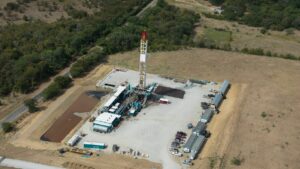 Hydraulic fracturing, often referred to as fracking, has revolutionized the energy industry by unlocking vast reserves of oil and natural gas previously deemed inaccessible. This cutting-edge technique involves injecting high-pressure fluid into subterranean rock formations to create fractures, enabling the extraction of valuable resources. As global energy demands soar, hydraulic fracturing has emerged as a key player in meeting these needs, offering a significant boost to production capabilities. While fracking has sparked debates over environmental concerns, its role in advancing production techniques can’t be overlooked. The process has not only increased energy output but also reduced dependency on foreign oil, positioning countries to harness their natural resources more effectively.
Hydraulic fracturing, often referred to as fracking, has revolutionized the energy industry by unlocking vast reserves of oil and natural gas previously deemed inaccessible. This cutting-edge technique involves injecting high-pressure fluid into subterranean rock formations to create fractures, enabling the extraction of valuable resources. As global energy demands soar, hydraulic fracturing has emerged as a key player in meeting these needs, offering a significant boost to production capabilities. While fracking has sparked debates over environmental concerns, its role in advancing production techniques can’t be overlooked. The process has not only increased energy output but also reduced dependency on foreign oil, positioning countries to harness their natural resources more effectively.
Hydraulic Fracturing Is An Advancement In Production Techniques
Hydraulic fracturing revolutionizes energy production by unlocking resources once trapped in tight rock formations. This technique fundamentally transforms the energy landscape by boosting efficiency and accessibility.
The Basics of Hydraulic Fracturing
 Hydraulic fracturing, or fracking, involves injecting a high-pressure mixture of water, sand, and chemicals into underground rock formations. This process creates fractures in rock layers such as shale, allowing previously trapped oil and natural gas to flow freely. By accessing these reserves, fracking significantly enhances energy output. Fracking operations typically follow four key stages: well construction, resource identification, hydraulic fracturing, and resource extraction. Advanced technologies like 3D seismic imaging and horizontal drilling ensure precise targeting of resource-rich areas, reducing environmental footprint and maximizing yield.
Hydraulic fracturing, or fracking, involves injecting a high-pressure mixture of water, sand, and chemicals into underground rock formations. This process creates fractures in rock layers such as shale, allowing previously trapped oil and natural gas to flow freely. By accessing these reserves, fracking significantly enhances energy output. Fracking operations typically follow four key stages: well construction, resource identification, hydraulic fracturing, and resource extraction. Advanced technologies like 3D seismic imaging and horizontal drilling ensure precise targeting of resource-rich areas, reducing environmental footprint and maximizing yield.
History and Development of the Technique
The origins of hydraulic fracturing date back to the 1940s, when the first successful experimental applications occurred. The technique evolved over several decades, with significant advancements in the 1990s that enabled commercial viability. Horizontal drilling, coupled with advanced fracture mapping, transformed fracking from an experimental method into a mainstream production technique. The 21st century saw the rise of unconventional resource extraction, most notably in shale gas and tight oil. This resurgence reshaped global energy markets, decreasing dependence on imported fuels and stimulating economic growth in resource-rich regions. As technology continues to advance, hydraulic fracturing remains at the forefront of energy innovation, adapting to environmental and regulatory challenges while maintaining production efficiency.
How Hydraulic Fracturing Works
Hydraulic fracturing employs advanced techniques to extract oil and natural gas from deep rock formations. It involves several technological components and processes while considering environmental aspects.
Technological Components
 Hydraulic fracturing relies on sophisticated technologies. Horizontal drilling enables access to extensive rock layers, increasing extraction potential. Advanced 3D seismic imaging helps map underground formations, identifying optimal drilling sites. Pumps inject a high-pressure fluid mixture, crucial for creating fractures in rock formations.
Hydraulic fracturing relies on sophisticated technologies. Horizontal drilling enables access to extensive rock layers, increasing extraction potential. Advanced 3D seismic imaging helps map underground formations, identifying optimal drilling sites. Pumps inject a high-pressure fluid mixture, crucial for creating fractures in rock formations.
Key processes include drilling, fracturing, and extraction. Initially, vertical wells are drilled and extended horizontally through targeted formations. A high-pressure fluid mixture, consisting of water, sand, and chemicals, is injected to fracture the rock. These fractures allow trapped oil and gas to flow into the wellbore, facilitating extraction.
Benefits of Hydraulic Fracturing in Production
Hydraulic fracturing revolutionizes oil and natural gas extraction by increasing efficiency and productivity. It offers numerous advantages that cater to both economic growth and energy security.
Enhanced Extraction Efficiency
Hydraulic fracturing increases the extraction efficiency of oil and gas fields. It enables access to reserves previously deemed uneconomical by fracturing rock formations and facilitating resource flow. Technologies like horizontal drilling extend the reach within formations, optimizing resource recovery and minimizing surface disturbance. This efficiency ensures maximum output from each drilling site.
Challenges and Controversies
Hydraulic fracturing undoubtedly stands as a game-changer in energy production but it doesn’t come without its set of challenges and controversies. Environmental concerns remain at the forefront with debates over water usage and potential contamination sparking significant public discourse. Critics argue that despite technological advancements the risk of air quality degradation and seismic activity cannot be ignored. Balancing these environmental impacts with the undeniable economic and energy benefits of fracking continues to be a critical issue for policymakers and industry leaders. As the world navigates toward sustainable energy solutions understanding the full spectrum of fracking’s implications is essential. The ongoing challenge lies in leveraging the technique’s potential while ensuring responsible management of environmental risks.

